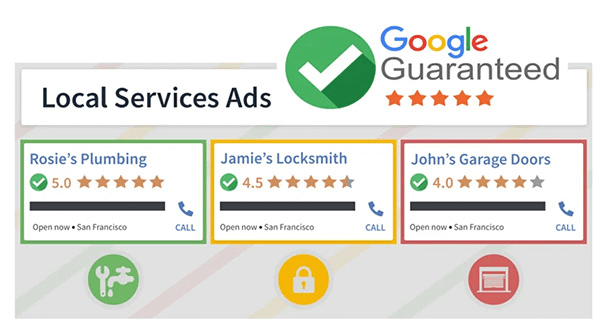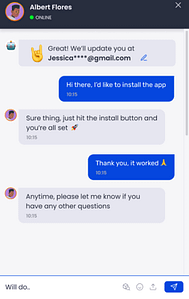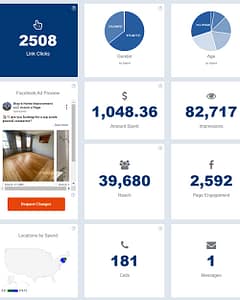Key Indicators to Watch
Establishing a niche for your home services business requires a comprehensive online marketing strategy. This strategy should encompass a strong online presence, optimized listings, a user-friendly website, targeted advertising, and active social media engagement.
Effective marketing increases brand visibility, builds trust with potential customers, and positions your business prominently in search results, particularly through Google Local Services Ads. These efforts collectively enhance brand awareness and provide a competitive advantage in a saturated market.
Listings
When building a successful online marketing campaign for your home services business, having up-to-date business listings is a critical component. Think of these listings as the digital equivalent of a phone book entry, but with more dynamic content and the ability to influence how your business appears in local search results.
- Start with your NAP – Name, Address, and Phone number. Ensure this information is consistent across all platforms to boost your local SEO. This consistency helps search engines trust your business’s legitimacy, which can improve your ranking in search results.
- Claim and optimize your Google Business Profile (GBP) profile. GBP is a powerful tool that allows customers to find, contact, and review your business directly from Google’s search results. Fill out every detail:
- Business category and description.
- Service areas.
- Hours of operation.
- Contact information.
- Add photos of your work, team, and before/after comparisons to give a personal touch and showcase your quality. This visual appeal can have a substantial effect on potential customers searching for home services.
- Encourage customer reviews and respond to them, demonstrating your engagement and customer service level. Positive reviews boost your credibility in the local search landscape.
Pro Tip: Local Splash prioritizes high-value listings over scattering efforts across numerous low-performing directories. Focusing on platforms that deliver the highest return on investment, such as Google Business Profile (GBP), Yelp, Facebook, and Bing, ensures that your business is prominently featured where it matters most. This targeted approach enhances visibility and drives more qualified leads to your services.
Remember: Regularly check your listings for accuracy, as outdated information can lead to lost opportunities and diminish trust with potential clients. Keep your listings updated with any changes in your business, such as new services or hours of operation. This attention to detail in your local listings can play a significant role in the overall success of your online marketing efforts.
Website

- Create a User-Friendly Website: Your website’s usability is key. It should be easy to navigate, fast-loading, and mobile-responsive to cater to the increasing number of users who access the internet via smartphones.
- Online Presence: A strong online presence is established through a combination of well-executed web design and ongoing SEO efforts. Your website content needs to be informative, relevant, and updated regularly to maintain its search rankings.
As Provided by Local Splash
Your website is the digital face of your home services business, and with Local Splash’s MySite service, it can stand out impressively. MySite offers customizable, SEO-optimized web designs that are mobile-friendly and fully secure, ensuring your business shines online.
From easy-to-use chat and scheduling options to integrated payment systems, MySite equips your site with the tools needed for success. Embrace the convenience of updating your website with no coding required, and let Local Splash’s expertise drive your online presence to new heights.
Key Elements of Your Website:
- Homepage: Introduce your services and unique selling proposition.
- About Page: Share the story behind your business and crew.
- Services Page: Clearly list the services you provide with detailed descriptions.
- Contact Page: Include an easy-to-use contact form and alternative contact methods.
- Blog or Resource Section: Offer valuable advice and tips related to your in-home services to help your SEO and provide value to visitors.
Ensure that your website reflects the quality of your work – make it as impeccable, approachable, and professional as your services.
Ads & Social
Navigating the world of online advertising can be overwhelming, but mastering platforms like Google Ads and social media can lead to significant growth for your home services business. By harnessing the power of paid ads and effective social messaging, you can connect with your ideal customers and increase your leads and revenues.
Google Ads PPC
With Google Adwords, you’re investing in visibility at the top of search engine results, directly above organic listings. This pay-per-click model ensures you only pay when potential customers click through to your website.
To optimize your Google Adwords campaign:
- Tailor Your Ads: Create ads specific to home services that resonate with your target audience.
- Set a Budget: Google Ads allows for flexible budgeting, making it a cost-effective choice for all sizes of businesses.
- Track and Analyze: Use Google’s robust tracking tools to monitor your conversion rate and adjust for the best ROI.
FB and Google Business Profile Post Generator
Effective use of social media starts with engaging content. Both Facebook and Google Business Profile offer post generators that can enhance your content marketing strategy.
- For Facebook:
- Ensure your content appeals to the local services ads market and utilizes Facebook’s extensive advertising strategies.
- Engage with your community using posts that highlight customer testimonials and examples of your work.
- For Google Business Profile:
- Take advantage of this free tool to appear in local search results and connect with those seeking home services.
- Regular posts about promotions or new services can improve your lead generation and keep your business top-of-mind.
The key is consistent, clear communication across these platforms, making sure your message aligns with your overall marketing campaigns. Use these spaces not just for advertising, but for building relationships with your audience.
LSA by Google
Local Services Ads (LSA) by Google have revolutionized the promotion of home service businesses online. These ads serve as an economical bridge, linking your business directly with potential clients who are in immediate need of the services you provide. Positioned at the very top of Google search results, LSAs ensure your business stands out prominently.
The Google Guarantee enhances this service by adding a layer of confidence for both you and your customers. In instances where customers, who found your business through LSAs, are not satisfied with the work quality, Google may step in.
The company holds the discretion to provide reimbursements to the customer for the amount spent on the initial service, with this safety net being subject to a cumulative cap throughout the life of the guarantee.
How LSAs Work:
- Targeted Exposure: LSAs help you appear to local customers based on their search queries.
- Pay Per Lead: You only pay when someone contacts you through the ad, making it a budget-friendly option.
Creating a Winning LSA Campaign:
- Verification: Ensure your business is properly vetted by Google to build trust with customers.
- Accurate Information: Input your business hours, services, and any required licenses.
- Budget Management: Decide how much you’re willing to spend on leads each week to control costs.
Benefits for Home Services:
- High Intent Leads: LSAs connect you with users who are ready to book a service, increasing the likelihood of conversion.
- Reviews and Ratings: Showcasing your positive reviews from satisfied customers can enhance your credibility.
By optimizing your LSA profile and managing your budget, you can develop an advertising strategy that boosts your visibility and is aligned with your financial goals. The key is to maintain an updated and detailed profile to maximize your lead generation efforts.
Tip: In the Local Splash client dashboard, you’ll find FBAds leads and LSA leads under the “Leads” tab.
Partner with Local Splash
To succeed in online marketing for your home services business, you need to establish a strong digital presence. This includes having optimized listings, a user-friendly website, strategic advertising, and active social media engagement.
With tools like Google Local Services Ads and effective use of platforms like Google Ads and Facebook, you can connect with potential customers and grow your business.
Local Splash stands ready to guide you through these complexities, ensuring that you can focus on what you do best – running your business. For a tailored approach to online marketing success, reach out to us today and discover how having the right partner makes all the difference!






